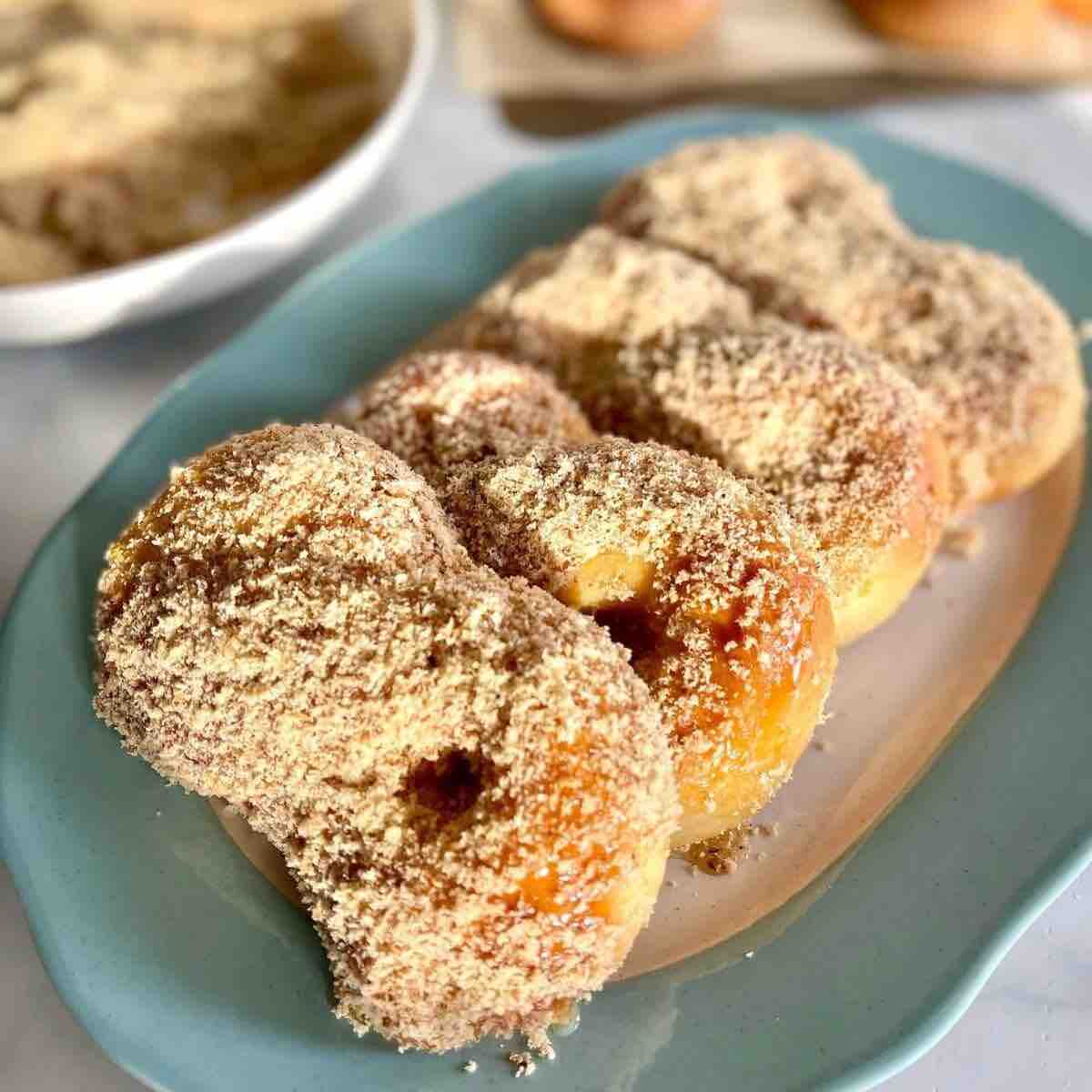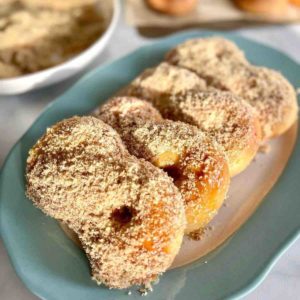Honey and Walnut Pastries (Sfintisori Moldovenesti)
Honey and Walnut Pastries, known as Moldavian Little Saints or “mucenici” in Romanian, are a beloved traditional dessert.

Honey and Walnut Pastries, known as Moldavian Little Saints or “mucenici” in Romanian, are a traditional dessert with a soft, fluffy texture and a sweet, nutty flavour.
Made with a simple dough infused with lemon peel and vanilla, these pastries are shaped into figure-eights, baked until golden, and then soaked in a fragrant syrup of sugar, water, and citrus peel.
Finally, they are brushed with honey and sprinkled with ground walnuts for a delightful finish.
If you enjoy baking you should try these recipes next One egg lemon pound cake, Super soft Jam-Filled Bread Roll, Easy Flourless Yogurt Cake: light and fluffy cheesecake, The BEST Mini Ricotta Cakes, Raspberry and Coconut Cake Recipe or Brownies Topped with Pink Berry Cream.
OUR LATEST VIDEOS
Looking for more? Check out these Baking Recipes!
I enjoy preparing restaurant-quality dishes that are both delicious and simple to recreate at home. Using fresh ingredients allows me to craft delightful recipes for my family while controlling the taste. Sharing homemade recipes creates special memories that last.
Expert Tips
- Ensure the yeast is activated properly by using warm milk and allowing it to rest for 10 minutes before proceeding with the recipe.
- Don’t rush the rising process; allow the dough to double in size during both proofing stages for a light and airy texture.
- When soaking the baked pastries in syrup, ensure they are completely cooled to prevent them from becoming soggy. Dip them briefly to absorb the flavors without making them too moist.
What is the history behind these pastries?
The history of Moldavian Little Saints, or “mucenici” in Romanian, is rooted in Romanian tradition and folklore. The name “mucenici” translates to “martyrs,” and the pastries are typically made and consumed on the Feast of the Forty Martyrs of Sebaste, a Christian holiday celebrated on March 9th.
Legend has it that during the Roman Empire, forty soldiers who refused to renounce their Christian faith were martyred by being left to freeze to death on a frozen lake in Sebaste (modern-day Sivas, Turkey). The martyrs are said to have sung hymns and prayers while enduring their fate, and the Feast of the Forty Martyrs commemorates their bravery and sacrifice.
The tradition of making Moldavian Little Saints on this feast day has evolved over time. The pastries are shaped into figure-eights to represent the number 40 and are often flavoured with lemon and honey, symbolizing purity and sweetness. They are shared among family and friends as a gesture of remembrance and celebration of the martyrs’ steadfast faith.
Today, Moldavian Little Saints remain a cherished part of Romanian culinary heritage, enjoyed not only on religious occasions but also as a beloved treat shared with loved ones.
Ingredients in my Honey and Walnut Pastries
To make the dough:
- Warm Milk: Use milk that is lukewarm to activate the yeast. It should be around 110°F (43°C). Too hot, and it will kill the yeast; too cold, and it won’t activate properly.
- Sugar: Provides sweetness to the dough and syrup. Use granulated sugar for best results.
- Melted Butter: Adds richness and flavor to the dough. Ensure it’s melted but not too hot when adding to the dough.
- Eggs: Eggs provide structure, richness, and color to the dough. Use large eggs at room temperature. The extra egg for the egg wash gives the pastries a glossy finish when baked.
- Dry Yeast: Leavening agent that helps the dough rise. Ensure the yeast is fresh and within its expiration date for optimal results.
- Flour: Provides structure and volume to the pastries. Use all-purpose flour for a balanced texture.
- Vanilla Extract: Enhances the flavor of the dough with a sweet and aromatic note. Use pure vanilla extract for the best flavor.
- Lemon Peel: Adds a subtle citrus flavor to the dough. Use a fresh lemon and avoid the white pith, which can impart a bitter taste.
For the syrup:
- Water: Forms the base of the syrup. Use filtered water for a clean taste.
- Sugar: Sweetens the syrup and helps to preserve it. Dissolve the sugar completely when making the syrup.
- Vanilla Extract: Adds flavor to the syrup. Use pure vanilla extract for the best taste.
- Orange and/or Lemon Peel: Infuses the syrup with citrus flavor. Use fresh, unwaxed citrus fruits for the best aroma and flavor.
For decoration:
- Honey: Adds sweetness and a glossy finish to the pastries. Use quality honey for the best flavor.
- Ground Walnuts: Provides a crunchy texture and nutty taste to the pastries. Toast the walnuts lightly before grinding for enhanced flavour.
Substitutes
Here are some possible substitutes for the ingredients without compromising the recipe:
To make the dough:
- Warm Milk: You can use warm water or a dairy-free milk alternative such as almond milk or soy milk.
- Sugar: Substitute with an equal amount of coconut sugar, maple syrup, or honey for a different flavour.
- Melted Butter: Replace with an equal amount of melted coconut oil or vegetable oil for a dairy-free option. For a richer flavour, you can use melted ghee.
- Eggs: Use a commercial egg replacer or make a flaxseed or chia seed “egg” by mixing 1 tablespoon of ground flaxseed or chia seeds with 3 tablespoons of water until gel-like.
- Dry Yeast: If you don’t have dry yeast, you can use an equal amount of active dry yeast or instant yeast.
- Flour: Gluten-free flour blends can be used as a substitute for wheat flour. Look for a 1:1 gluten-free flour blend for best results.
- Vanilla Extract: Replace with almond extract, maple extract, or vanilla bean paste.
- Lemon Peel: Substitute with orange peel or omit it entirely if you prefer a milder taste.
For the syrup:
- Water: You can use fruit juice such as orange juice or apple juice for a flavored syrup.
- Sugar: Replace with an equal amount of honey, maple syrup, or agave nectar.
- Vanilla Extract: Omit if you don’t have it on hand, or use almond extract.
- Orange and/or Lemon Peel: Use zest from other citrus fruits such as lime or grapefruit, or omit it entirely for a simpler syrup.
For decoration:
- Honey: Replace with maple syrup, agave nectar, or date syrup.
- Ground Walnuts: Substitute with ground almonds, pecans, or hazelnuts for a different nutty taste.
Storage and leftovers
Once cooled, store the pastries in an airtight container at room temperature for up to 3 days, or refrigerate for up to 1 week. Leftovers can be frozen for up to 2 months. Thaw in the refrigerator or at room temperature before reheating in the oven.
FAQs
Honey and Walnut Pastries, or “Mucenici” in Romanian, are a traditional dessert enjoyed especially in Moldova and Romania. These sweet pastries are shaped like the number eight and served with a fragrant syrup made of honey, walnuts, and spices. They are often prepared to celebrate the feast of the Little Saints (Mucenici) on March 9th, but are beloved all year round.
To shape the pastries, divide the dough into small portions and roll them into long ropes. Twist each rope into the figure-eight shape, ensuring the ends are securely tucked in. After baking, the pastries will hold their shape and soak up the delicious syrup.
You can bake them ahead of time, and store the cooled pastries in an airtight container overnight, ready to soak in the syrup the next day. This makes for an easy, make-ahead dessert!
The syrup is made by combining honey, water, a dash of vanilla, and ground walnuts, simmered together to create a sweet, rich mixture that soaks into the pastries. It’s the key component that makes these pastries so irresistible!
Feel free to experiment with different nuts or spices in the dough or syrup. While the traditional version uses walnuts, you can also try almonds, hazelnuts, or even pistachios. Adding a hint of cinnamon or orange zest to the syrup can bring a fresh twist!
PIN THIS RECIPE TO MAKE IT LATER


This reminds me of something my baba would make. I love the combination of honey and nuts. Perfect for dessert, great on the brunch menu too.
These are a crowd pleaser! With guests over I like to make something special to leave out for snacking and these are a hit!
I brought these to a brunch and got raving comments. They are well worth the time to make them. I liked that it uses pantry ingredients. So so good!
Honey and walnut knots are such a special treat for breakfast (Or tea. Or as snack. Or…). I really enjoyed making them. The lemon zest gives a great contrast to the sweetness and the syrup makes them utterly moreish.
wow these Honey and Walnut Pastries were amazing – so fluffy and addicting! My whole family couldn’t stop munching on them
These cuties were so good! I will make them again!
These little yeast bread pastries are so delicious! They have the perfect amount of sweetness and crunch thanks to the honey and walnuts.
These were delicious!!! The honey pushed them over the top and these didn’t last long!!
My kids will love this, thanks a lot for the nice recipe!